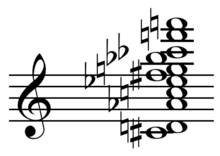Sound mass

In musical composition, a sound mass (also sound collective, sound complex, tone shower, sound crowd, or cloud) is the result of compositional techniques, in which, "the importance of individual pitches," is minimized, "in preference for texture, timbre, and dynamics as primary shapers of gesture and impact," obscuring, "the boundary between sound and noise" (Edwards 2001, pp. 326–27).
Techniques which may create or be used with sound mass include extended techniques such as muted brass or strings, flutter tonguing, wide vibrato, extreme ranges, and glissandos as the continuum for "sound mass" moves from simultaneously sounding notes – clusters etc., towards stochastic cloud textures, and 'mass structure' compositional textures which evolve over time (Edwards 2001, pp. 326–27). In a sound mass, "the traditional concept of 'chord' or vertical 'event' [is] replaced by a shifting, iridescent fabric of sound" (Kostka, Payne, and Schindler 1995, 546).
The use of "chords approaching timbres" begins with Debussy and Edgard Varèse often carefully scored individual instrumental parts so that they would fuse into one ensemble timbre or sound mass (Erickson 1975, pp. 18 and 21). Explored by Charles Ives and Henry Cowell in the early part of the twentieth century, this technique also developed from the modernist tone clusters and spread to orchestral writing by the mid 1950s and 1960s (Edwards 2001, pp. 326–27). "Unlike most tonal and non-tonal linear dissonances, tone clusters are essentially static. The individual pitches are of secondary importance; it is the sound mass that is foremost" (Reisberg 1975, p. 355). One French composer active in this period whose music takes a sound-mass approach directly influenced by both Debussy and Varèse is Maurice Ohana (Rae 2001).
Examples
Examples can be found in Metastasis (1953–54), Pithoprakta (1955–56), and Achorripsis (1956–57), all orchestral works by Iannis Xenakis (Salzman 1987, p. 185), as well as in Gesang der Jünglinge for concrete and electronic sounds (1955–56), Zeitmaße for five woodwinds (1955–56), and Gruppen for three orchestras (1955–57), by Karlheinz Stockhausen (Stockhausen 1963, p. 235). Other composers and works include Barbara Kolb, Pauline Oliveros' Sound Patterns for chorus (1961), Norma Beecroft's From Dreams of Brass for chorus (1963–1964), and Nancy Van de Vate. Beecroft "blurs individual pitches in favor of a collective timbre through the use of vocal and instrumental clusters, choral speech, narrator, and a wash of sounds from an electronic tape" (Edwards 2001, pp. 326–27).
A very early example is the opening of Jean-Féry Rebel's ballet Les Elémens (1737–38), where chaos is represented by a gradually cumulating orchestral cluster of all seven notes of the D minor scale (Henck 2004, pp. 52–54). A later example is the third movement of Ruth Crawford Seeger's String Quartet 1931 (recorded on Nonesuch H-71280) while more recently Phill Niblock's multiple drone based music serves as an example (Palmer 1982).
Other examples include European "textural" compositions of the fifties and sixties such as Krzysztof Penderecki's Threnody to the Victims of Hiroshima (1959) and György Ligeti's works featuring micropolyphony in works like Atmosphères (1961) and his Requiem (1963–65) (Anon. n.d.). Other composers with works using this technique include Henryk Górecki, Karel Husa, Witold Lutosławski, Kazimierz Serocki, Steven Stucky, and George Crumb (Anon. n.d.). Sound-mass techniques also appear in the music of Monic Cecconi-Botella (Andrieux 2001) and Harry Freedman (Dixon 2004, 93).
See also
Sources
- Andrieux, Françoise (2001). "Cecconi-Botella, Monic". The New Grove Dictionary of Music and Musicians, second edition, edited by Stanley Sadie and John Tyrrell. London: Macmillan Publishers.
- Anon. (n.d.) "Synopsis of Twentieth Century Styles and Composers". University of Northern Colorado website (Archive from 2 September 2005, accessed 20 October 2011).
- Babbitt, Milton: String Quartet No. 2; Ruth Crawford Seeger: String Quartet; George Perle: String Quartet No. 5. Composers Quartet. Program notes, principally by Robert P. Morgan, on slipcase. LP recording, 1 disc: analog, 12 in, 33⅓ rpm. Nonesuch H-71280. New York: Nonesuch Records, 1973.
- Dixon, Gail Susan (2004). The Music of Harry Freedman. University of Toronto. ISBN 9780802089649.
- Edwards, J. Michele (2001). "North America since 1920". In Women & Music: A History, second edition, edited by Karin Pendle. Bloomington: Indiana University Press. ISBN 0-253-21422-X.
- Erickson, Robert (1975). Sound Structure in Music. University of California Press. ISBN 0-520-02376-5.
- Henck, Herbert (2004). Klaviercluster: Geschichte, Theorie und Praxis einer Klanggestalt. Signale aus Köln 9. Münster: LIT Verlag. ISBN 3-8258-7560-1.
- Kostka, Stefan M., Dorothy Payne, and Allan Schindler (1995). Tonal Harmony, third edition. New York: McGraw-Hill, Inc. ISBN 9780070358744.
- Palmer, Robert. 1982. "Modern Twists on the Ancient Drone". The New York Times (8 August): 2:17col1 (accessed18 November 2016)
- Rae, Caroline (2001). "Ohana, Maurice". The New Grove Dictionary of Music and Musicians, second edition, edited by Stanley Sadie and John Tyrrell. London: Macmillan Publishers.
- Reisberg, Horace (1975). "The Vertical Dimension". In Aspects of Twentieth-Century Music, edited by Richard DeLone and Gary Wittlich. Englewood Cliffs, NJ: Prentice-Hall. ISBN 9780130493460.
- Salzman, Eric (1987). Twentieth-Century Music: An Introduction, third edition. Prentice-Hall History of Music Series. Englewood Cliffs, N.J: Prentice-Hall. ISBN 0-13-935057-8.
- Stockhausen, Karlheinz (1963). "Erfindung und Entdeckung". In his Texte zur Musik 1, edited by Dieter Schnebel, 222–58. DuMont Dokumente. Cologne: Verlag M. DuMont Schauberg.
Further reading
- Kohl, Jerome (2017). Karlheinz Stockhausen: Zeitmaße. Landmarks in Music Since 1950, edited by Wyndham Thomas. Abingdon, Oxon; London; New York: Routledge. ISBN 978-0-7546-5334-9.
- Kokoras, Panayiotis (2005). Towards a Holophonic Musical Texture. In proceedings of the ICMC2005 – International Computer Music Conference. Barcelona, Spain.
- Xenakis, Iannis (1992). Formalized Music: Thought and Mathematics in Composition, second, expanded edition. Harmonologia Series No. 6. Stuyvesant, NY: Pendragon Press. ISBN 1-57647-079-2. Reprinted, Hillsdale, NY: Pendragon Press, 2001.